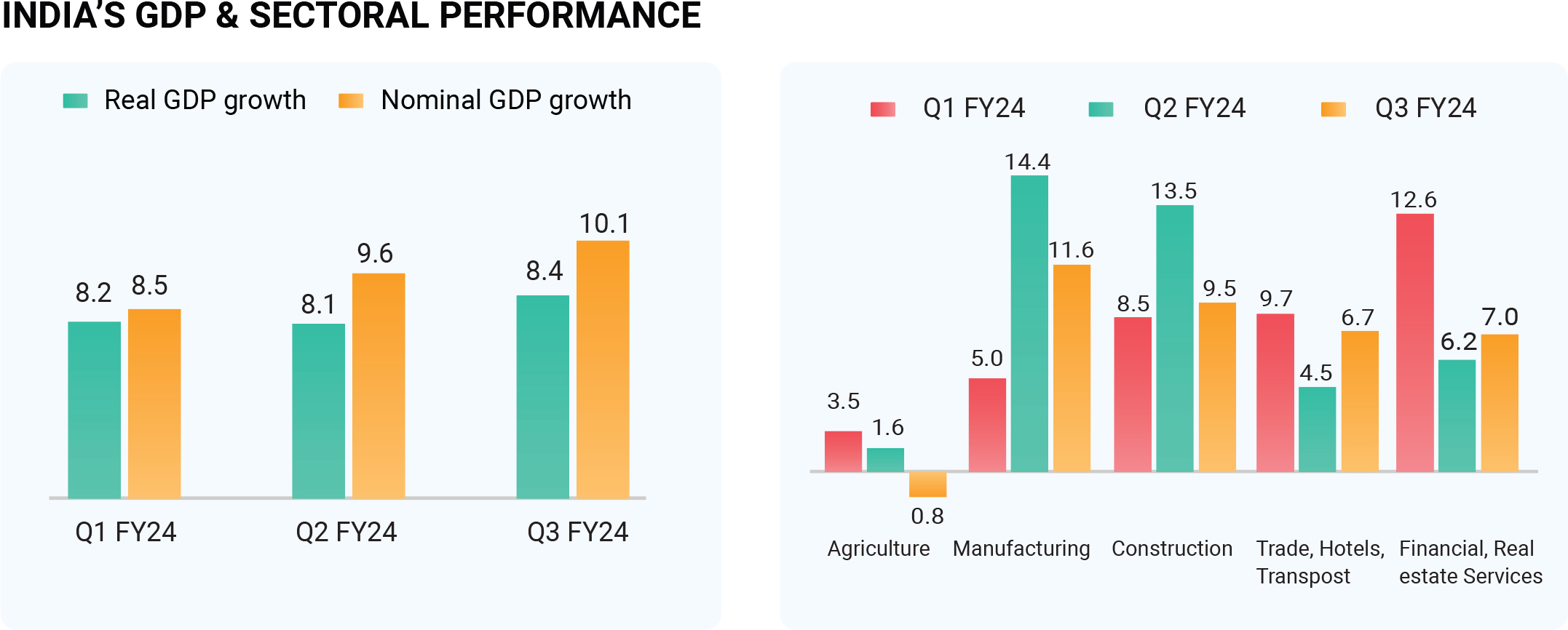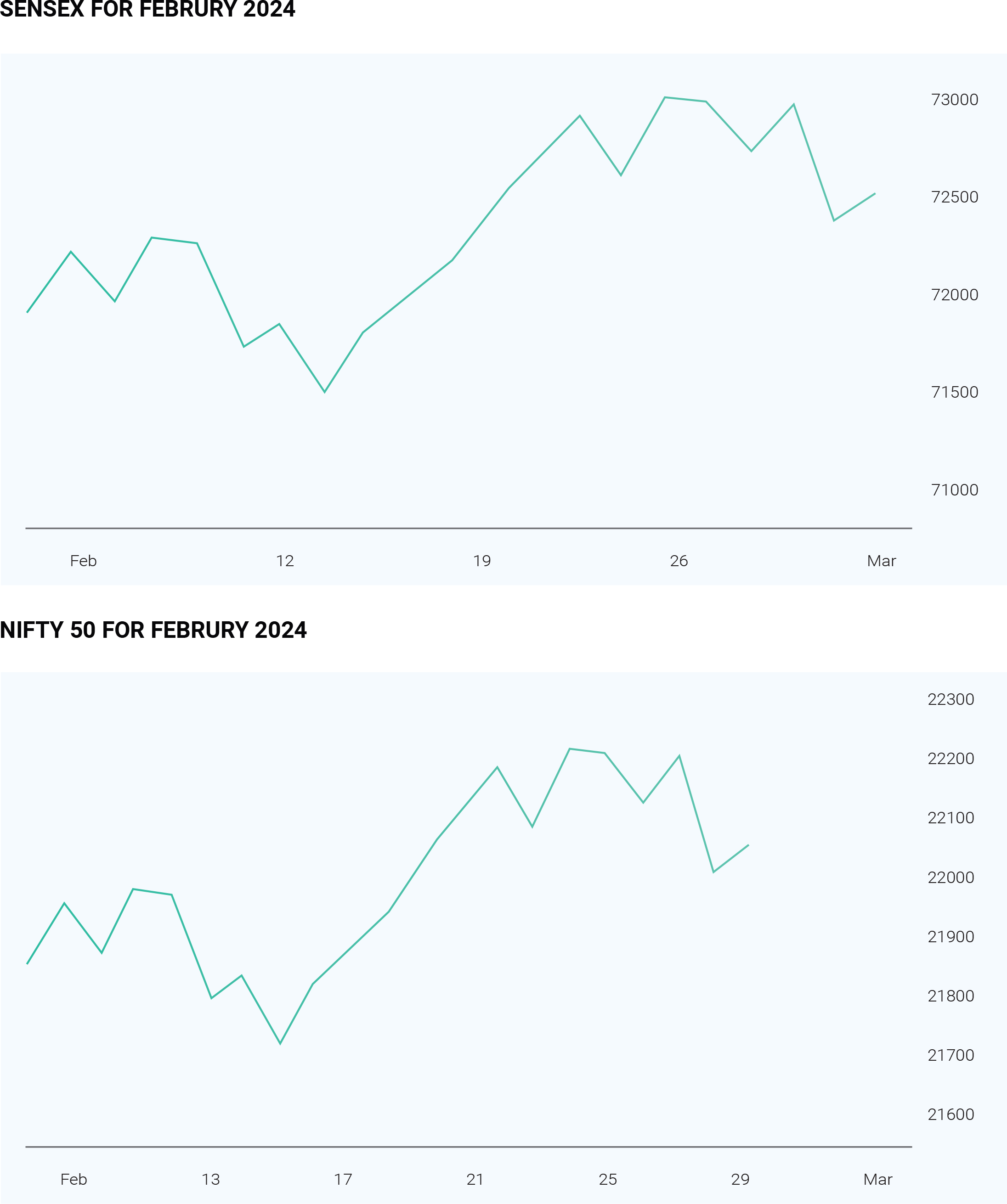In February 2024, the month commenced with the
unveiling of Interim Budget 2024, laying the groundwork
for targeted growth initiatives amidst economic
challenges. The market response to the Budget was
mixed. Focused on infrastructure development and fiscal
prudence, the Budget echoed the government's
commitment to fostering a stronger economy. During the
second week, the MPC meeting maintained unchanged
rates, in line with market expectations. However,
mid-month witnessed a setback as the Sensex dropped
approximately 500 points due to elevated US inflation,
sparking a sell-off in Asian markets. By month-end,
Indian equity markets rebounded, reaching all-time
highs.
The benchmark equity indices, BSE Sensex and BSE
MidCap, advanced over 1%, while the BSE SmallCap
index experienced a 1.09% retreat. Notably, at least 13
stocks listed on BSE more than doubled investors'
wealth. Following the disclosure of the country's Q3FY23
GDP growth of 8.4% on February 29, the markets
exhibited a sharp rise. On March 1, the Sensex surged
over 1,000 points in the afternoon trade, with the Nifty
index up over 300 points. Both indices achieved new
all-time highs, propelled by buying activity fuelled by
various domestic and global macroeconomic factors.
BSE Sensex reached a new record high of 73,819.21,
ultimately rallying 1,245.05 points (1.72%) to settle at
1245.05. NSE's Nifty50 surpassed the 22,350-mark for
the first time, settling at 22,338.75, reflecting a surge of
355.95 points (1.62%) for the day.
While the BSE midcap index added less than a percent,
the smallcap index rose two-thirds of a percent. The fear
gauge in India eased more than 2%, concluding the week
at 15.24 levels. Nifty IT, media, healthcare, and pharma
stocks lagged, but a rally was steered by buying in
financials, banks, metals, and auto sectors.
As the month concluded, the markets exhibited positive
momentum driven by various factors, including:
India's GDP Numbers:
The Indian economy surged, registering a growth rate of
8.4% in the December 2023 quarter, surpassing initial
estimates. This robust expansion was fuelled by a
dynamic manufacturing and construction sector,
marking the fastest economic growth in six quarters.
With a remarkable 11.6% annual growth in the
manufacturing sector and a 9.5% increase in the
construction sector in the third quarter, the FY24
estimate was revised upward to 7.6% from 7%. Despite a
contraction of 0.8% in the agriculture sector due to
adverse monsoon conditions and El-Nino impact, the
overall economic journey positions India as a favoured
destination for investors.
US Inflation Data:
US inflation eased to 2.4% in January 2024, aligning with
the US Federal Reserve's inflation target. The in-line
readings of US inflation reinforced expectations for a
potential rate cut in June. The positive economic climate
was evident as US stocks settled higher, with the Nasdaq
reaching a record high close after over two years. This
rally was fuelled by investor optimism, buoyed by
better-than-expected Core PCE numbers and the Fed's
expected inflation gauge meeting consensus forecasts.
Globally, indices remained upbeat, sustaining hopes for
central bank rate cuts in the upcoming months. Investors
expressed confidence in both the US Federal Reserve
and the European Central Bank for potentially lowering
borrowing costs in June.

Positive FII Data:
Notwithstanding Foreign Portfolio Investors (FPIs)
turning net sellers of domestic stocks on the last day of
February, the overall month displayed positive trends.
NSE data indicated FPIs selling domestic stocks worth
Rs 3,568.11 crore, while domestic institutional investors
(DIIs) divested Rs 230.21 crore in Indian equities in the
previous session. Despite these sell-offs, overseas
investors injected a total of Rs 1,539 crore into local
equities throughout February. FPIs, reversing January's
selling streak, became net buyers in February,
showcasing resilience despite the backdrop of high US
bond yields. Although the capital outflow from Indian
equities by FPIs in 2024 reached ₹20,004 crore, the
positive trend continued as FPIs infused ₹4,201 crore in
Indian equities on March 1, despite offloading ₹134 crore
from the debt market. FPIs were prominent sellers in the
financials and FMCG sectors in February, but their
outflow declined, culminating in them becoming net
buyers by the end of the month.
Blue Chip Buying and High Auto Sales:
The markets witnessed an upswing fuelled by buying in
index heavyweights. Notably, ICICI Bank, HDFC Bank,
Reliance Industries, and Larsen & Toubro collectively
contributed around 60% of the 1,245 points rally
observed in the Sensex during the session. Key gainers
included State Bank of India and Tata Steel. Indian
automakers reported strong sales in February, with
increased demand for two-wheelers and utility vehicles.
Companies such as TVS Motors, Maruti Suzuki India,
Tata Motors, Hero MotoCorp, and Bajaj Auto all
experienced positive gains.
In summary, the positive trajectory at the close of the
month was shaped by a confluence of favourable
economic indicators, robust market activities, and
investor confidence in both domestic and global
contexts. Global developments, such as upcoming
elections in India and the US, escalating crude prices,
recovery in major economies, global and domestic
macroeconomic data, geopolitical tensions, and foreign
capital inflows, have significantly impacted the market
dynamics.
In February, crude oil prices experienced a 2% increase in
the previous session, reflecting weekly gains. Traders
eagerly awaited the decision on supply agreements for
the second quarter by the Organization of the Petroleum
Exporting Countries and its allies (OPEC+). The market
sentiment was also influenced by fresh economic data
from the US, Europe, and China. Brent futures for May
settled $1.64 higher, reaching $83.55 a barrel, while the
April Brent futures contract expired at $83.62 a barrel on
February 29. Meanwhile, US West Texas Intermediate
(WTI) for April rose by $1.71 (2.19%), closing at $79.97 a
barrel, as reported by Reuters. Analysts speculated that
OPEC+ was expected to maintain voluntary production
cuts well into the second quarter of 2024. Several key
economic indicators are anticipated to impact the
market in the near future. Notable among these are
China's Caixin Services PMI, inflation figures, UK S&P
Global/CIPS Services PMI and Construction PMI, US S&P
Global Services PMI, API weekly crude oil stock, ADP
nonfarm employment change, initial jobless claims, and
the unemployment rate. While the overall market
sentiment appears positive, the possibility of volatility
cannot be overlooked, given the prominent role played by
global concerns. The market will likely remain sensitive
to developments in geopolitical landscapes, economic
data releases, and any unforeseen events that may
impact the stability of major economies and influence
investor confidence.


